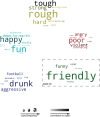The language of marketing hyperbole and consumer perception-The case of Glasgow
- PMID: 38117850
- PMCID: PMC10732446
- DOI: 10.1371/journal.pone.0295132
The language of marketing hyperbole and consumer perception-The case of Glasgow
Abstract
The aim of the study was to explore the potential of a timed word association task to generate detailed insights into the perception of Glasgow city and its people which could inform destination and brand marketing. Destination marketers have a challenge to convey the tourist destination image to attract and satisfy the expectations of its visitors. Yet destination perceptions are often the result of multiple tourist visitor experiences at a location, neglecting the voice of the resident. The extent to which word associations varied by participants' relationship to Glasgow was identified in terms of Aaker's brand personality scale, an extension of personality research on brands and destinations. Surveying of 1,219 UK participants generated a total of 5,993 terms (city; 1,144 unique) and 5,034 terms (people; 944 unique). The value of capturing the perceptions of a destination by its residents is identified. The results showed that the city of Glasgow was often described as cold and busy, while the people were primarily described as friendly and funny. Evidence was found in support of dual-processing theory suggesting word associations based on lived experiences of a city may be generated later (in terms of the order in which the terms were generated) in a word association task, while common linguistic associations (e.g. synonyms, antonyms, hierarchies etc.) tend to be generated earlier in the task. As hypothesised, analyses revealed a significant relationship between several of the Aaker-dimensions of brand personality, and the consumers' relationship to Glasgow, extending marketing research with an empirical approach to identifying differences in the perceived personality of a destination. The study offers a practical, fast, and replicable method for destination marketers to study consumer perception at scale, which is currently not widely utilised in this field. In particular, the use of semantic distance and word embeddings provides a readily available approach to automatically categorise content derived from word associations studies, or indeed, any text-based content. In contrast, financial investment in non-validated branding and destination marketing campaigns appear to be increasingly problematic. Advances were made in testing an approach to interpreting word associations through the lens of linguistic and situated simulation (LASS) theory to provide deeper analysis to both categorise and interpret consumers' perception. Traditional approaches to tourism marketing and destination branding rarely provide such a level of analytical appraisal. The analysis presented in this paper challenges the orthodoxy and validity of investment in brand and destination marketing at a city level and the potential for word association tasks to be used as a valuable alternative method to create more effective destination marketing and branding.
Copyright: © 2023 MacNiven et al. This is an open access article distributed under the terms of the Creative Commons Attribution License, which permits unrestricted use, distribution, and reproduction in any medium, provided the original author and source are credited.
Conflict of interest statement
The authors have declared that no competing interests exist.
Figures











References
-
- Andrews S, Duggan P. Performance as City Pandemic Response: Invitations to Innovate. 2021.
-
- Centre Moffat. Scottish Occupancy and Accommodation Survey. Glasgow: Glasgow Caledonian University; 2022.
-
- Huggins R, Prokop D, Thompson P. UK Competitiveness Index 2021. 2021.
-
- Singhal S, McGreal S, Berry J. An evaluative model for city competitiveness: Application to UK cities. Land Use Policy. 2013;30: 214–222.
-
- WTTC. World Travel and Tourism Council. 2021. Available: https://wttc.org/News-Article/WTTC-research-reveals-Travel-and-Tourism-s...
MeSH terms
LinkOut - more resources
Full Text Sources
Research Materials

